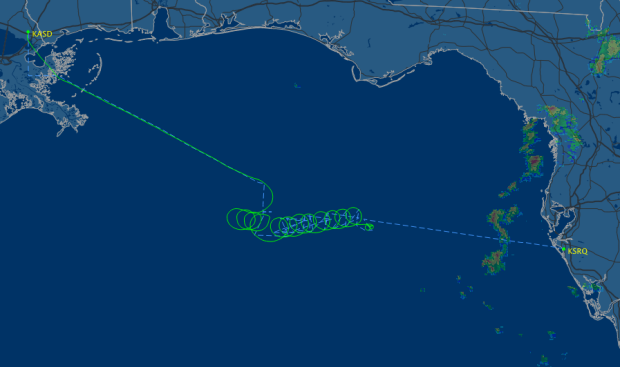Live flight tracking site FlightAware shows destinations and current routes. It’s everyday stuff for the most part, but around noon time today, a plane was circling above the ocean and crashed into the Gulf of Mexico.
The Air Force, which had dispatched fighter jets to monitor the twin-engine Cessna 421, reported it crashed about 12:10 p.m., said Lt. Cmdr. Christopher O’Neil, a Coast Guard spokesman. The aircraft had been circling over the Gulf about 200 miles south of Panama City, Florida, another spokesman, Chief Petty Officer John Edwards, told CNN.
The plane took off from Slidell, Louisiana, en route to Sarasota, Florida, with a single pilot on board, a Federal Aviation Administration source told CNN. It had been circling at an altitude of about 28,000 feet.
Whoa.
[via @DataJunkie]



Due to story targeting (another result of data), I am now seeing other stories about aviation that all have maps from FlightAware when I visit certain web sites!
This site is a treasure trove though. You can get any information about any commercial flight and most civilian flights. For security, most of the “live” information is delayed by an hour or so.
The green line is actually not the true flight path. The aircraft sends a series of data points that form fragments of the actual flight path. Some type of curve fitting is performed to estimate the actual flight path based on the timestamps. What is cool about this site is that you can click on pretty much anything and get different cross sections of information.
To clarify: the green line is an interpolated path derived from target samples from FAA radar facilities. There are occasional places where an aircraft is between radar coverage where larger interpolation has to be done, but it’s not common. The tie-up from target signal to transponder code to flight number / tail number is done by the FAA’s controllers. The dashed path on the map is the flight plan (series of waypoints or navaids) filed with the FAA before the flight (and occasionally updated en route).
In Europe, and slowly catching on in the US, is the ADS-B standard, which relies less on a massive network of radar facilities, and instead on the aircraft transmitting their location themselves. It turns out you can easily receive this data using cheap radios and a little software, which is what makes hobbyist receiver networks like planefinder.net possible (with real-time data directly from the aircraft). As it becomes mandatory in the US (part of the NextGen airspace bill), I’d expect to see a couple orders of magnitude increase in the amount of flight data available on the internet, and lots of fun projects coming from it.
Another interesting site is http://www.flightradar24.com/ I used this when there was the Icelandic ash cloud, and you could see where no planes were flying! A related site is marine traffic.com, http://www.marinetraffic.com/ais/ where, once you zoom in you can get ship cargo type, course and speed data.
Those are cool sites! flightradar24 seems to only have like 3 flights shown as leaving or arriving at LAX which can’t be right. I wonder what feed they are using.
Did the plane carry oxygen? That’s too high. He must have passed out while the plane was climbing and succumb to oxygen deprivation.
That type of plane is apparently pressurized, but likely failed or something. Same thing happened to Payne Stewart (sp?) if that is what happened to that plane.